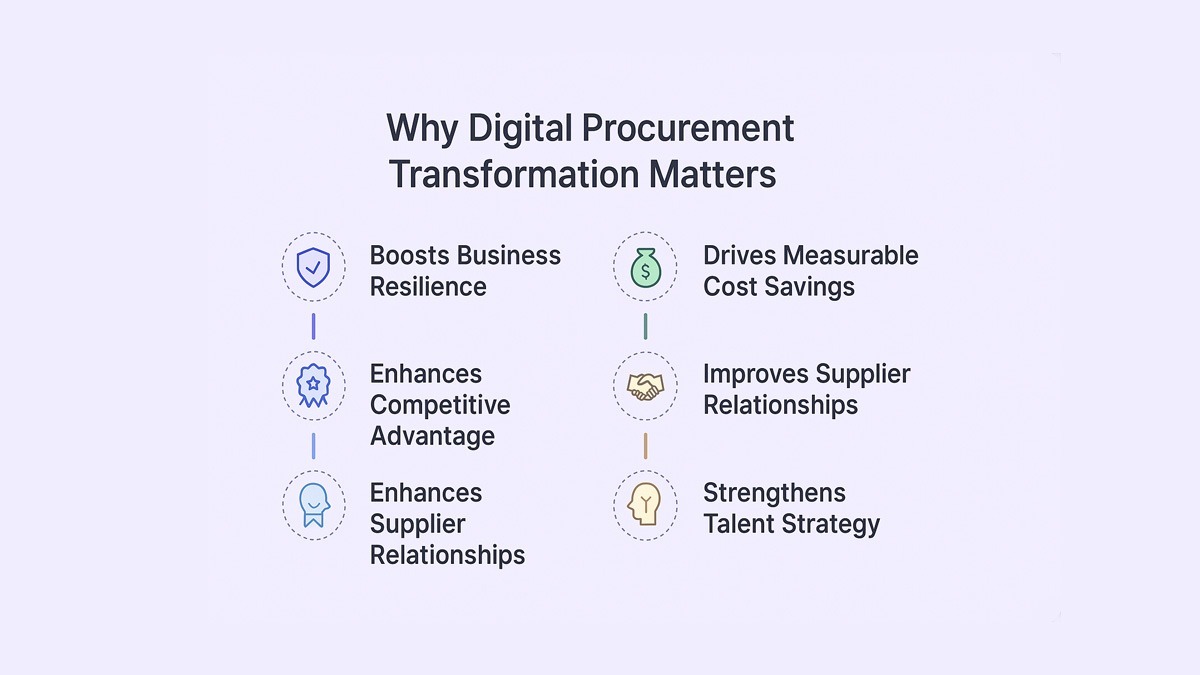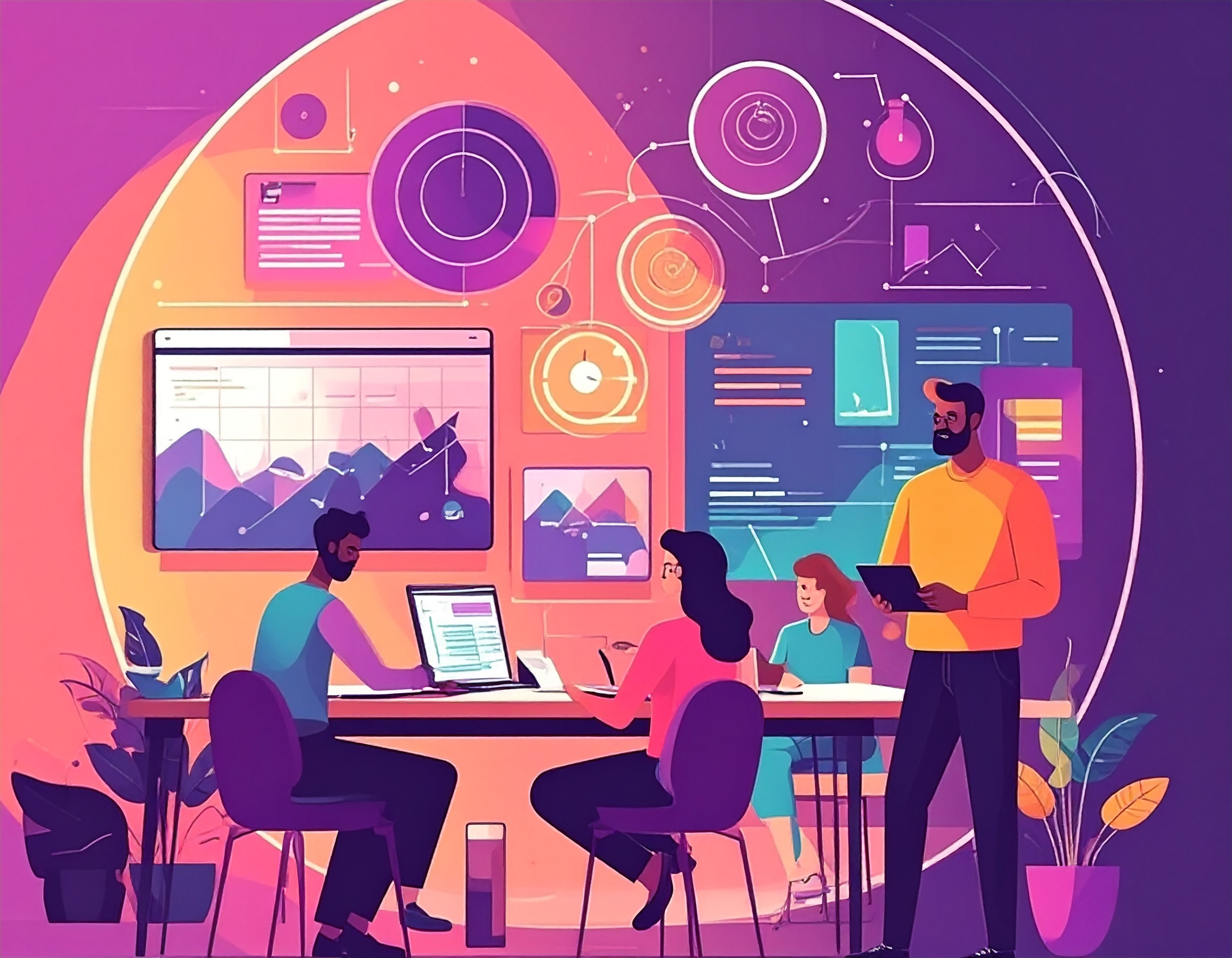

Digital Procurement Transformation: Why It’s the Game-Changer Nobody Talks About

Digital Procurement Transformation: Why It’s the Game-Changer Nobody Talks About
Learn how digital procurement transformation drives cost savings, resilience, and agility through automation and smarter vendor management.


“Digital transformation is no longer a buzzword, it's a business necessity,” says Gartner’s 2024 CxO report, which found that 67% of finance leaders are prioritizing automation to manage rising costs.
Procurement is no exception. Once seen as a back-office task, it’s now a strategic driver for efficiency, resilience, and growth. As companies look to do more with less, technology is redefining how teams purchase, track, and optimize everything from software to services.
What is Digital Procurement Transformation?
Digital procurement transformation is the use of technology to modernize procurement. It automates manual tasks, applies data for smarter decisions, and uses cloud tools for sourcing, contracting, and supplier management, helping businesses save costs, improve speed, and stay agile.
Why Digital Procurement Transformation Matters?
Digital procurement isn’t just about doing things faster - it’s about doing them smarter. Here’s why organizations are making the switch:

1. Boosts Business Resilience
In times of disruption - think supply chain breakdowns or budget freezes - digitized procurement processes ensure continuity. Real-time visibility, automated approvals, and centralized vendor data help teams respond quickly, reroute spend, or shift suppliers without chaos.
2. Drives Measurable Cost Savings
Manual processes are riddled with inefficiencies. Digitization closes those gaps. It also helps compress the payment cycle, making vendor settlements faster and more predictable. Automation prevents over-ordering, duplicate purchases, and missed renewals. Strong procurement spend management ensures resources are allocated efficiently and waste is minimized. It also enables better benchmarking and spend analysis, which means procurement teams can negotiate from a position of strength.
3. Enhances Competitive Advantage
Speed and agility win markets. With digital procurement, companies reduce cycle times, onboard vendors faster, and seize market opportunities before competitors can even file a requisition form. It’s not just operational efficiency - it’s a strategic edge.
4. Improves Supplier Relationships
Digital tools help streamline communication and reduce friction in the supplier lifecycle. From automated updates to transparent performance tracking, vendors know where they stand - and that builds trust. It also opens the door for collaborative innovation with strategic partners.
5. Strengthens Talent Strategy
Procurement talent today isn’t just about negotiation - it’s about navigating tech platforms, analyzing data, and managing stakeholders. Digitization frees teams from repetitive admin work so they can focus on strategy, upskill, and become true value creators.
Key Pillars of Digital Procurement Transformation
Digital procurement transformation doesn’t happen overnight. It requires strategy, structure, and a clear roadmap for adoption. The five pillars of digital procurement transformation form the foundation for long-term success.
1. Design for User Experience
Adoption is the biggest challenge in any digital initiative. Procurement tools must be intuitive, easy to navigate, and built for the people using them daily. When users can complete requests, approvals, and renewals without friction, transformation sticks.
2. Invest in Change Management and Talent
Technology alone doesn’t drive transformation, people do. Equip teams with the right training, communicate the “why” behind every change, and encourage collaboration across departments. Skilled procurement professionals who can manage both data and relationships are key to success.
3. Build a Unified Tech Stack
A fragmented system limits visibility and slows decision-making. A unified procurement architecture connects sourcing, contracting, invoicing, and spend analytics in one place. This ensures data accuracy, speeds up reporting, and improves cross-functional coordination.
4. Pick the Right Use Case
Start small to build confidence. Identify areas where digital tools can deliver early wins like automating purchase orders or vendor onboarding. These quick successes create momentum and buy-in for broader adoption.
5. Establish Governance and Compliance
Strong governance protects against risk and keeps operations audit-ready. Set clear approval workflows, vendor assessment standards, and renewal timelines. Regular compliance checks help maintain control while scaling.
Key Aspects of Digital Procurement Transformation
Digital procurement transformation is more than just upgrading tools, it’s about creating smarter, faster, and more connected operations. It combines automation, AI, and analytics to make procurement proactive rather than reactive. By centralizing data and enabling collaboration, teams can improve efficiency, manage risks, and focus on strategic value instead of routine tasks.
A) Core Technological and Process Elements
1. Automation
Automating repetitive tasks such as invoice processing, purchase order creation, and approvals reduces errors and accelerates procurement cycles. It also frees teams to focus on higher-value work that supports business growth.
2. Artificial Intelligence (AI)
AI and machine learning analyze large datasets to predict market trends, evaluate supplier performance, and identify opportunities for savings. Intelligent recommendations help procurement teams make faster and more informed decisions.
3. Data Analytics
Advanced analytics tools provide real-time visibility into spending, supplier performance, and contract compliance. With clear data visualization, finance and procurement leaders can spot inefficiencies and guide strategic planning.
4. Centralized Platforms
Integrated, cloud-based platforms connect every stage of procurement from sourcing and contract management to payments. This unified view ensures accuracy, transparency, and collaboration across teams and suppliers.
B) Strategic and Operational Outcomes
1. Increased Efficiency and Speed
Digital tools streamline workflows, reduce manual input, and shorten approval cycles, helping teams move from request to purchase faster.
2. Cost Reduction
Data-driven insights uncover savings opportunities, optimize vendor negotiations, and cut down on manual process costs.
3. Improved Collaboration
Online supplier portals and shared digital workspaces enable real-time communication, improving transparency and strengthening vendor relationships.
4. Enhanced Risk Management
With real-time analytics, teams can spot potential supplier or compliance risks early and act quickly to prevent disruptions.
5. Strategic Shift
By automating tactical work, procurement professionals gain time to focus on strategy, supplier partnerships, and innovation that drive long-term value.
Common Barriers to Digital Procurement Transformation
While the benefits are clear, the path to digital transformation isn’t without its hurdles. Many organizations hit roadblocks that slow progress or derail initiatives. Here are some of the most common challenges:
1. Change Resistance Within Teams
Let’s face it - people are creatures of habit. Shifting from spreadsheets and emails to automated workflows can feel daunting. Procurement teams may fear losing control, while other departments resist new systems they perceive as “extra work.” Without strong change management, adoption stalls before it starts.
2. Lack of Clear ROI
Many companies struggle to build a compelling business case for digital transformation. Procurement leaders may sense the value, but without clear metrics or benchmarks, it’s hard to justify new investments. This makes it tough to get buy-in from finance or the C-suite.
3. Fragmented Procurement Systems
In large or fast-growing organizations, procurement often happens in silos - each team using its own tools, processes, or vendor lists. This fragmentation leads to inconsistent data, duplicate spend, and a lack of central control. Connecting the dots becomes a technical and organizational challenge.
The 7-Step Roadmap for a Successful Digital Procurement Transformation Strategy
A successful procurement transformation strategy doesn’t happen by chance. It’s built on a clear plan, strong leadership, and continuous improvement. Here are 7 steps for creating a successful procurement transformation strategy that helps teams move from manual processes to a modern, data-driven function.
Step 1. Spot Current Issues and Pain Points
Every transformation begins with understanding the current state. Audit existing procurement processes to identify inefficiencies, data gaps, and manual bottlenecks. Mapping out the pain points helps you prioritize what to fix first and builds the foundation for your procurement transformation roadmap.
Step 2. Develop a Transformation Roadmap
A roadmap defines where you’re going and how to get there. Set clear objectives whether it’s reducing costs, improving supplier visibility, or accelerating approvals. Establish milestones, timelines, and KPIs to measure progress along the way.
Step 3. Secure Executive Buy-In
Leadership support is often the difference between success and failure. Present a clear business case that highlights ROI, efficiency gains, and risk reduction. When executives understand the value of digital procurement, they are more likely to champion the initiative across teams.
Step 4. Implement Digital Solutions
Start with a phased rollout. Pilot key tools like automation, analytics dashboards, or centralized procurement platforms in select departments. Learn from early results, refine workflows, and then scale organization-wide.
Step 5. Invest in Change Management and Talent Development
Technology adoption depends on people. Train teams to use new tools confidently and communicate how these changes make their work easier. Upskilling employees builds confidence and ensures long-term adoption.
Step 6. Engage Suppliers as Partners
Treat suppliers as part of your digital journey. Use online collaboration platforms and transparent communication to build stronger relationships. When suppliers are aligned, procurement becomes more efficient and resilient.
Step 7. Monitor Results and Drive Continuous Improvement
Measure the impact of your transformation regularly. Track KPIs like cost savings, cycle times, and supplier performance. Use these insights to refine your procurement transformation strategy and identify new opportunities for optimization.
Best Practices for a Successful Digital Procurement Transformation
Going digital in procurement isn’t just about picking the right tool - it’s about rethinking how your team operates and collaborates. Success comes from aligning people, processes, and platforms. Below are the best practices that make digital procurement transformation stick - and deliver long-term value.

1. Start With a Clear Roadmap
Before jumping into automation or new tech, outline a clear transformation roadmap. Define your goals - whether it’s cost savings, faster approvals, or better compliance - and map them to specific processes. Prioritize low-hanging fruit that delivers quick wins and builds momentum. Optimizing the source-to-pay process improves consistency and tracking throughout the procurement lifecycle.
2. Invest in the Right Tools
Not all procurement software is created equal. Choose platforms that integrate easily with your existing systems (ERP, finance, etc.), offer real-time analytics, and are user-friendly. A flexible digital architecture ensures these systems adapt well to future procurement needs. Look for scalability - tools that can grow with your business - and ensure your vendor provides strong onboarding and support. The entire source to pay cycle becomes easier to manage with the right digital infrastructure in place.
3. Train and Upskill Procurement Teams
Digital tools are only as effective as the people using them. Equip your teams with the training they need to use new platforms confidently. Cloud automation can reduce the workload on teams by handling routine procurement tasks automatically. Beyond the “how-tos,” focus on strategic skills - like data analysis, supplier collaboration, and stakeholder communication - that empower procurement to act as a business enabler.
Leveraging AI and Advanced Analytics in Digital Procurement Transformation
Artificial Intelligence (AI) and Machine Learning (ML) are changing how procurement teams plan, source, and measure success. Leveraging AI in procurement transformation helps organizations move from reactive cost control to proactive decision-making.
As automation matures, AI’s role in your digital roadmap will only grow stronger, enabling smarter forecasts, faster sourcing, and better visibility into performance.
1. Predictive Spend Analysis
AI and ML use historical and real-time data to forecast spending patterns, highlight cost-saving opportunities, and detect risks before they occur. By analyzing trends across suppliers, categories, and contracts, predictive analytics helps finance and procurement leaders anticipate needs, prevent overspending, and negotiate better deals.
It transforms spend management from a backward-looking report into a forward-looking strategy.
2. Autonomous Sourcing
AI-powered sourcing automates supplier discovery, bid evaluation, and negotiation support. Instead of relying on manual searches and spreadsheets, algorithms assess vendor performance, pricing models, and compliance in seconds.
Procurement teams can use these insights to shortlist qualified suppliers, compare competitive bids, and finalize decisions faster all while reducing bias and improving transparency.
3. Rethinking Procurement Performance
AI-driven analytics redefine how procurement success is measured. Traditional KPIs like cost savings and cycle time are now joined by new value streams such as supplier innovation, sustainability, and risk mitigation.
Using dashboards powered by ML, teams gain a real-time view of supplier performance, spend under management, and contract efficiency. This shift encourages continuous improvement and strategic impact across the organization.
How Spendflo Helps With Digital Procurement Transformation
Procurement leaders today are under constant pressure to deliver savings while managing an ever-growing stack of tools, contracts, and compliance requirements. For many, digital transformation feels like a moving target hard to start, harder to scale.
That’s where Spendflo makes the difference. A leading tech company recently reduced its SaaS overspend by 30% and cut approval time in half after switching to Spendflo’s unified platform. By centralizing vendor data, automating renewals, and adding real-time visibility into every purchase, their finance and procurement teams turned a manual process into a strategic advantage.
The truth is, spreadsheets and disconnected systems can only take you so far. To keep pace with change, you need a system that grows with you, one that simplifies procurement from intake to payment. Spendflo delivers exactly that. It brings AI, automation, and expert-driven support together to help you save more, move faster, and gain total control over your spend.
Ready to make procurement transformation real for your business?
Book a free demo with Spendflo and see how you can start achieving measurable savings today!
Frequently Asked Questions on Digital Procurement Transformation
What are the benefits of digital procurement transformation?
Digital procurement improves efficiency, reduces manual errors, and helps companies gain real-time visibility into their spend. It also enables faster decision-making, stronger supplier relationships, and better compliance across procurement workflows.
How does digital procurement transformation impact supplier relationships?
It fosters transparency and collaboration. Digital tools allow for real-time communication, shared dashboards, performance tracking, and streamlined contract management - leading to more trust and fewer misunderstandings with suppliers.
What tools enable digital procurement transformation?
Tools like procurement management platforms, spend analytics software, supplier portals, contract lifecycle management (CLM) systems, and integration-ready ERPs are key enablers of digital transformation in procurement.
Can small businesses benefit from digital procurement transformation?
Absolutely. Even small teams gain from automating repetitive tasks, gaining spend visibility, and managing vendors in a centralized way. Cloud-based solutions make it easier and more affordable for SMBs to go digital without complex setup.
What role does artificial intelligence play in procurement today?
Artificial intelligence helps procurement teams automate repetitive tasks, forecast demand, and evaluate vendor performance. It also supports AI-based selection of suppliers, making the sourcing process faster, data-driven, and less prone to bias.
How do procurement services help manage compliance issues?
Procurement services provide tools and frameworks to enforce compliance management, monitor vendor risks, and ensure procurement practices meet internal policies and external regulations.
Why are supplier contract negotiations critical for procurement success?
Effective supplier contract negotiations ensure fair pricing, better terms, and stronger relationships. Leveraging technology can make these negotiations more strategic and aligned with company goals.










.png)




.png)










.avif)





